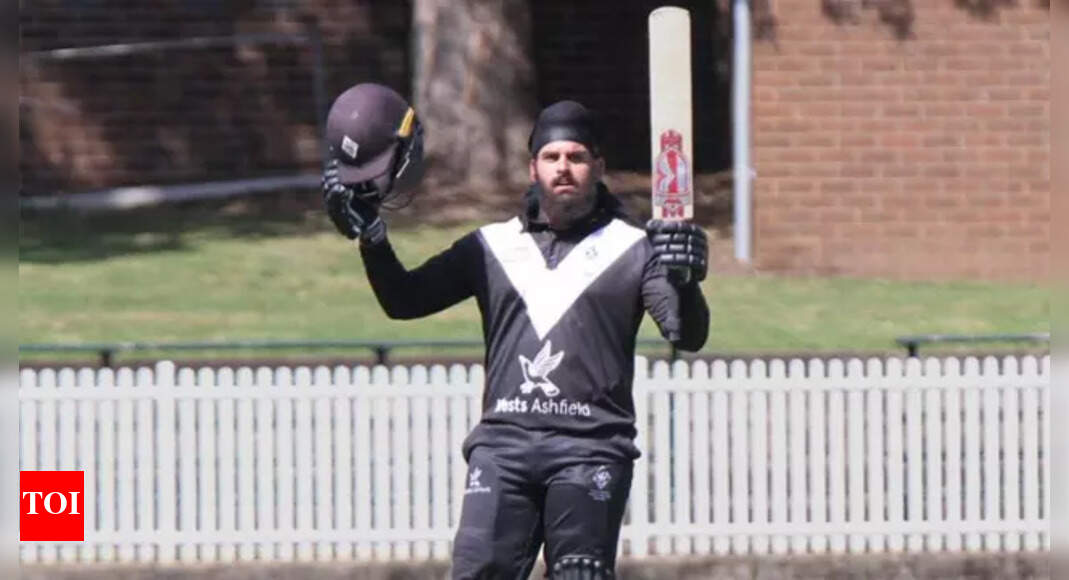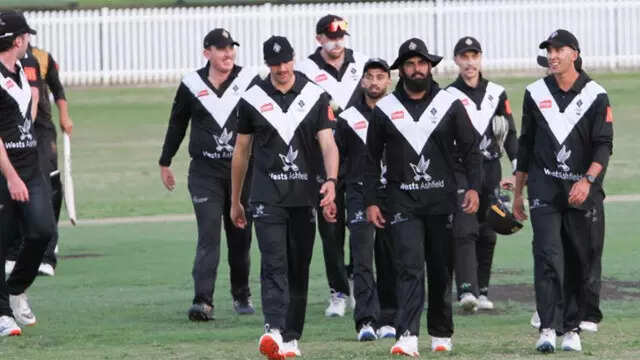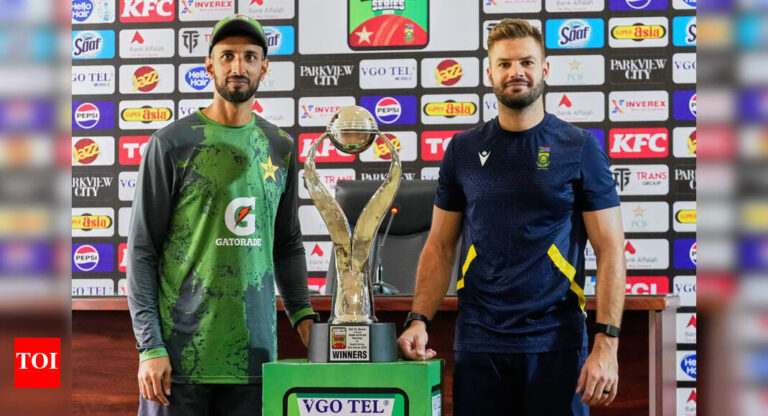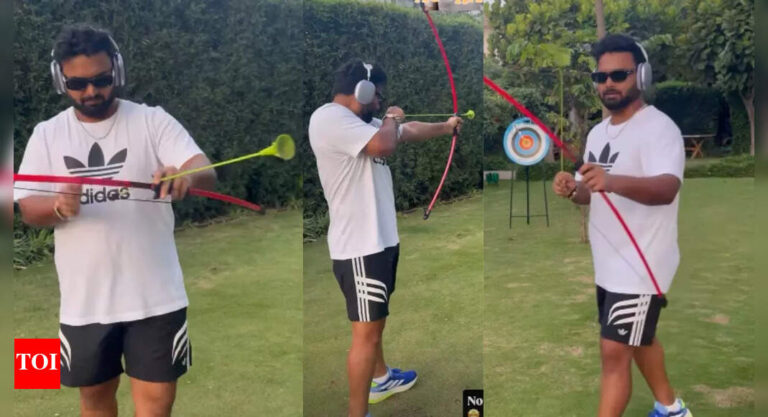
NEW DELHI: Harjas Singh was Australia U-19’s top scorer with a feisty 55 against India U-19 in the U-19 World Cup final last year. His timely knock helped Australia win the U-19 title for the first time in 14 years.Harjas’ teammate Sam Konstas went on to play Test cricket for Australia, debuting against India in the Border-Gavaskar Trophy last year. The likes of Oliver Peake, Harry Dixon, and Callum Vidler have been fast-tracked to Australia A. Meanwhile, Harjas has had to grind it out to make a name for himself.Go Beyond The Boundary with our YouTube channel. SUBSCRIBE NOW!“Most of my teammates are playing for Australia A or are in the Australia squad. It makes no difference. Everyone has their own journeys, their own paths, their own timeframe,” the 20-year-old tells TimesofIndia.com.“I think credit to all of them. They’ve all worked extremely hard. Everyone’s on a different timeframe. You could still go pro at 25, or at 27, or you could go pro at 16, like some of the greats such as Sachin (Tendulkar),” he says.In the past week, Harjas has become the toast of Australian cricket. He has appeared on podcasts with former Australia captains Michael Clarke and Brad Haddin and earned a maiden New South Wales second XI call-up.
Poll
Do you believe Harjas Singh’s success will inspire more immigrant cricketers?
He achieved all this after smashing a remarkable 314 not out from 141 balls — a whirlwind knock that featured 35 sixes and helped his club, Western Suburbs, post 483 for 5 against Sydney Cricket Club at Ashfield’s Pratten Park. The next-best scorer from his team made 37 as Western Suburbs won by 186 runs.Coming in to bat at No. 3 in the 11th over, the 20-year-old raced to his century in the 35th over, taking just 74 balls to reach the milestone. He then went on a stunning assault, smashing 214 runs off his next 67 deliveries. The knock became the third-highest individual score in NSW Premier first-grade history and broke a century-old record for the most sixes in an innings — surpassing Victor Trumper’s 22 for Paddington against Redfern in the 1902/03 season.Harjas was later informed that approximately $2000 worth of cricket balls had gone missing during his carnage. “It was fun,” he laughs.“Honestly, I have no idea how I hit those runs and sixes. After 100, my intention was to just hit every ball for six. And yeah, they just kept going, so I just kept swinging,” he adds.Harjas says that Australian Premier First Grade cricket is highly competitive and that this is where players earn contracts for Sheffield Shield teams and catch the attention of Big Bash League (BBL) franchises.“It’s one level below where you become a professional cricketer. All the professional cricketers from Australia who play state cricket are chosen from New South Wales first grade,” explains Singh, who was trained by Neil D’Costa in his early years. D’Costa has coached the likes of Michael Clarke, Phil Hughes, and Marnus Labuschagne, to name a few.

Family’s sacrificeHarjas comes from a family of sportspersons. His father was a state boxing champion in Punjab, while his mother was a long jumper. They left Chandigarh and moved to Australia in 2000.Being an immigrant with roots in Chandigarh, the 20-year-old grew up watching his parents, Inderjit Singh and Avinder Kaur, work tirelessly to support his cricketing dreams.“My parents are bus drivers, both of them,” he says.“For every parent who has a son who is a cricketer, sacrifices always have to be made — straight after work, taking them to training, late nights, early mornings, making sure their clothes are ready when they were younger. Financially, it’s a big thing too — buying pads, bats, all that stuff,” he says.Harjas still visits Chandigarh, where his uncle and other family members live.“I went to Chandigarh two years ago. We live in Sector 44-D. I still have family back in Chandigarh and Amritsar,” he says.A couple of years ago, in a podcast with SBS Punjabi, the youngster shared how he had to work harder than others because of his identity.“If you look different from others, you have to do something different and much more to maintain that identity and your place in the field,” he had said.Talking about his parents’ reaction after his record-breaking knock, Harjas says: “My family’s reaction was priceless. During the innings break, I spoke to my mom. She said, ‘I checked your score when you were on 260 and couldn’t believe it — my legs started shaking.’ And my dad, when I spoke to him, was in tears. It was quite emotional and special.”The change in techniqueHarjas admits he has tweaked his technique recently, which has helped him hit those monstrous sixes.“I’ve definitely worked on it. It’s something I’ve focused on throughout the off-season. I’ve been doing that with my coach Darius (Visser) at Hype Cricket. It’s been in the works for about three or four months,” he says.This wasn’t the first time he has changed his technique.Harjas is right-handed in almost everything he does — except batting. The switch, he recalls, happened by chance during his childhood. As a kid, he used to bat right-handed in the backyard, but with glass windows on the leg side, there was always a risk of breaking them. To avoid that, he began batting left-handed and has stuck with it ever since. Interestingly, he still bowls right-arm medium pace and throws with his right hand.In his brief career, Harjas has also moved around a lot in the batting order.“I move around in different formats. For my club currently in Tier II, I open the batting. In one-day matches, I bat at number three, and in two-day games, I bat at number four,” he says.

More eyeballsFor someone so young, Harjas has a mature head on his shoulders and isn’t bothered by the attention he’s receiving.“After 35 sixes, there will be more eyeballs for sure. I’m not going to let that distract me from doing my job, which is scoring runs,” he says.“I don’t think it’s overwhelming,” he reasons.“I mean, it’s definitely something I’ll look out for in the future, which thankfully I’m ready for now. It has caught me a little off guard, but that’s all part of it, and it’s something I have to manage,” he adds.“When you’re on social media, you get all sorts of attention — good and bad. It’s a different skill to not let it affect you and to stay focused on what you need to do. Again, my main aim is to perform in the next match,” he says.When asked about his maturity, the youngster smiles: “I think it’s something I’ve ingrained into my speech and my actions. It hasn’t been easy, but it’s definitely been a journey.”The futureOn his podcast, Michael Clarke predicted that the youngster will soon receive contracts from IPL and BBL teams. But Harjas isn’t getting carried away — he knows consistency is key.“There’s a long way to go. One innings doesn’t define your career. You need consistency and back-to-back performances,” he says.“Honestly, I couldn’t tell you about my future or where I’ll be in a few years. My aim is to perform in the next match I play. I like to take things day by day and not look too far ahead,” he says.Harjas is a true Gen Z kid, unbothered about what the future holds. For now, he wants to groove to Karan Aujla’s hit song “Gabhru,” enjoy homemade Shahi Paneer, and promises to go after his own record.“I’ll go for it again for sure,” he signs off.






